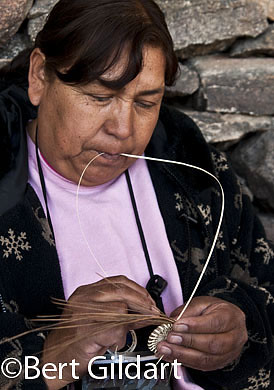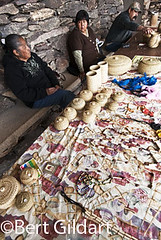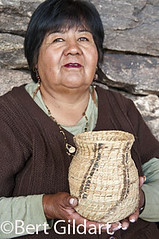Archaeoastronomy Weekend at Anza Borrego

Daria Aquiar of Baja California and a member of the Paipai nation demonstrates basket making techniques.
©Bert Gildart: This past weekend Anza Borrego Desert State Park in southern California presented its annual Archaeoastronomy weekend, opening its museums for visitor tours – and hosting a tribe of Native Americans.
The group is known as the Paipai and they hale from the Santa Catarina area of the Baja Pennisula, which is located about a four hour drive south of Anza Borrego. As many who follow our blog know, Janie and I have a particular interest in Native Americans and have, in fact, devoted an entire page of our website to the Gwich’in Indians of Alaska.
Over the years, my stories and photographs of Native Americans have appeared in dozens of publications to include Christian Science Monitor, Native Peoples Magazine, National Wildlife and Time/Life.
PAIPAI INDIANS PRESERVE THEIR PAST
The presence of the Paipai at the Visitor Center this past weekend provided us with an opportunity to meet a group of people who are actively attempting to preserve their indigenous ways, specifically, by the continued creation of baskets, bows and arrows, and pottery.
But the weekend was also about the area’s ancient past, and not to gloss over the work of all the volunteer archaeologists, the weekend also provided insights into a time when mammoths, zebras, llamas, camels, and ancient horses roamed the shores of ancient inland seas that once spread north from the Sea of Cortez. Indeed, the archaeological weekend provided not only a number of photographic opportunities, but also an excellent time to learn about the area’s incredible past.
MADE FROM PINE NEEDLES
Because most of the Native artists spoke Spanish, Horacio Moncada served as a translator for artists Enriqueta Castro, Melina Zazueta and Adan Arenivar. He said the baskets were made from Jeffrey pine needles and palm leaves to create the intricately coiled pine leaves. They are proud that their use does not harm the trees as leaves and needles are gathered from those that have fallen to the ground. Horacio said that techniques for making the items were handed down over a period of almost 1,000 years.
Adan Arenivar created the bows and arrows and the sling shot, and with the exception of the rubber for the sling shot, all materials were derived from the land.
Click for enlarged version and to see extended caption.
Our visits with members of the Paipai Tribe occurred immediately in front of the Visitor Center, but not so tours of the museum. Normally, the area is off limits, but during this special weekend tours were conducted into actual working labs. Judy Smith, an RVer and also a volunteer who has undergone intense training, explained that zebras, sloths, and camels once occupied what is now the badlands terrain. From this area, the park has amassed a rich collection of bones.
HORSES DIED OUT
Archaeologists have then identified the bones and the results are amazing. Zebras and camels once occupied the area, but so, too, did horses and llamas. Interesting, these latter two species then migrated, horse to Asia and llamas to South America. Then, several million years ago those in North America all died out.
Click for enlarged version and to see extended caption.
In other words, though horses and llamas evolved here and later populated other portions of the world, it was up to the Spanish explorers to reintroduce horses, and up to the Mexicans to reintroduce llamas by bringing them across the isthmus of Panama.
During the weekend, the park also offered a number of seminars, many of which we attended. All were interesting, but for us, the opportunity to meet another group of Native Americans and some of the actual field people now serving as volunteers was the highlight.
—————————————————————————————————
THIS TIME THREE YEARS AGO:
*A Letter To Save The Everglades








May 15th, 2012 at 4:47 pm
What year was the first airstream made?